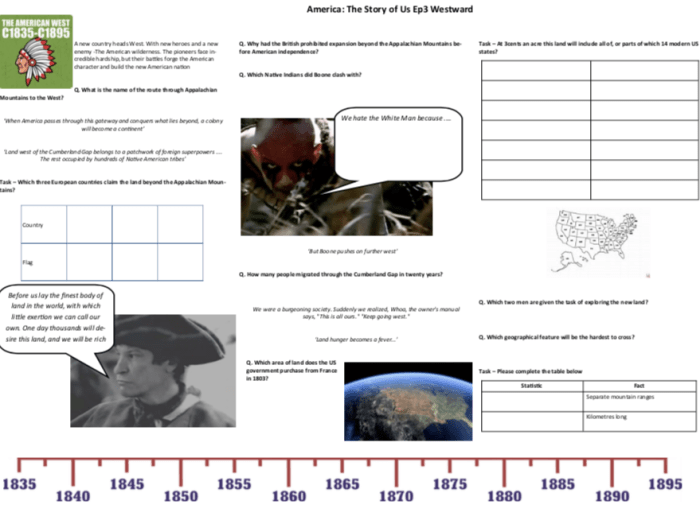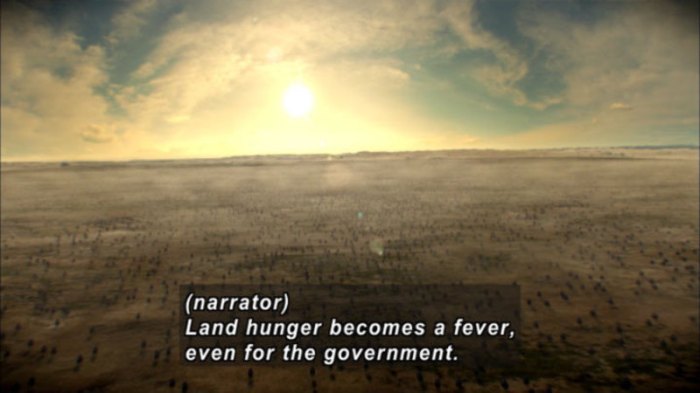America the Story of Us Westward Worksheet PDF Answers unveils a captivating account of the transformative era of westward expansion in American history. This comprehensive guide delves into the motivations, challenges, and profound impact of this pivotal movement, providing a deeper understanding of its significance in shaping the nation’s destiny.
As settlers embarked on their westward journeys, driven by the allure of Manifest Destiny, they encountered diverse Native American cultures and engaged in complex interactions that would forever alter the landscape of the American frontier. The Homestead Act, a defining piece of legislation, played a pivotal role in westward expansion, offering opportunities for land acquisition and shaping the development of agriculture and communities.
Westward Expansion: Manifest Destiny

Westward expansion was driven by the concept of Manifest Destiny, a belief that it was the divine right and duty of the United States to expand its territory across the North American continent.
Manifest Destiny justified westward expansion in several ways. First, it argued that the United States was a superior civilization destined to spread its values and institutions across the continent. Second, it claimed that the expansion of the United States was necessary to secure its national security and prevent other powers from gaining control of the West.
Third, it argued that westward expansion would provide economic opportunities for Americans and help to build a stronger and more prosperous nation.
Motivations for Westward Expansion
The motivations behind westward expansion were complex and included a combination of economic, political, and social factors.
- Economic motivations:The West offered vast opportunities for economic gain, including the availability of cheap land, mineral resources, and new markets for American goods.
- Political motivations:Westward expansion helped to strengthen the United States’ national identity and secure its borders. It also allowed the United States to acquire new territories and expand its sphere of influence.
- Social motivations:Many Americans saw westward expansion as a chance to escape the social and economic problems of the East and start a new life in the West.
Native American Displacement
Westward expansion had a devastating impact on Native American tribes. As American settlers moved west, they often displaced Native Americans from their traditional lands, forcing them to move to reservations or assimilate into American society.
Methods of Native American Displacement
- Treaties:The United States government often negotiated treaties with Native American tribes, which resulted in the tribes ceding their lands to the United States.
- Force:The United States government also used force to remove Native Americans from their lands, often through the use of military force.
- Assimilation:The United States government also attempted to assimilate Native Americans into American society through policies such as the Indian Removal Act and the Dawes Act.
Consequences of Native American Displacement
- Loss of land:Westward expansion resulted in the loss of millions of acres of land for Native American tribes.
- Loss of culture:The displacement of Native Americans from their traditional lands led to the loss of their cultures and traditions.
- Loss of identity:The assimilation policies of the United States government led to the loss of Native American identity for many Native Americans.
The Homestead Act and Land Acquisition
The Homestead Act of 1862 was a significant piece of legislation that encouraged westward expansion by offering free land to settlers who were willing to farm it.
Provisions of the Homestead Act
- Free land:The Homestead Act granted 160 acres of free land to any American citizen or immigrant who was at least 21 years old and had never borne arms against the United States.
- Requirements:To receive a land grant, settlers had to live on the land for at least five years and improve it by building a house and farming it.
- Success rate:About 10% of homesteaders were able to successfully claim their land and build a farm.
Challenges Faced by Homesteaders
- Harsh climate:Many homesteaders faced harsh climate conditions, such as droughts, floods, and blizzards.
- Lack of resources:Homesteaders often lacked access to basic resources, such as water, food, and supplies.
- Native American resistance:Some homesteaders faced resistance from Native American tribes who were unwilling to give up their land.
Transportation and Communication

The development of transportation and communication systems played a vital role in facilitating westward expansion.
Transportation
- Railroads:The construction of railroads made it possible to transport people and goods quickly and efficiently across the continent.
- Canals:Canals, such as the Erie Canal, also helped to facilitate westward expansion by providing a waterway for transporting goods.
- Wagon trails:Wagon trails, such as the Oregon Trail, were used by settlers to travel west.
Communication
- Telegraph lines:Telegraph lines allowed for the rapid transmission of information across the continent.
- Pony Express:The Pony Express was a mail delivery service that used horses to transport mail across the continent.
Economic and Social Impact: America The Story Of Us Westward Worksheet Pdf Answers
Westward expansion had a significant economic and social impact on the United States.
Economic Impact, America the story of us westward worksheet pdf answers
- Growth of agriculture:Westward expansion led to the growth of agriculture in the United States, as settlers established farms and ranches on the new lands.
- Growth of mining:Westward expansion also led to the growth of mining in the United States, as settlers discovered valuable mineral resources in the West.
- Growth of industry:The growth of agriculture and mining in the West led to the growth of industry in the United States, as factories were built to process raw materials and produce goods for the new markets in the West.
Social Impact
- Formation of new communities:Westward expansion led to the formation of new communities in the West, as settlers established towns and cities.
- Transformation of the American frontier:Westward expansion transformed the American frontier, as settlers moved west and established new ways of life.
- Legacy of westward expansion:The legacy of westward expansion continues to shape American history and culture, as the United States continues to grapple with the consequences of its expansionist policies.
Quick FAQs
What was the significance of Manifest Destiny in westward expansion?
Manifest Destiny was a belief that it was the divine right of the United States to expand its territory westward across the North American continent.
How did the Homestead Act impact westward expansion?
The Homestead Act offered free land to settlers who were willing to live on and cultivate it for five years, significantly encouraging westward migration.
What were the consequences of Native American displacement during westward expansion?
Native American tribes faced forced removal from their ancestral lands, loss of cultural identity, and devastating population declines due to disease and warfare.
